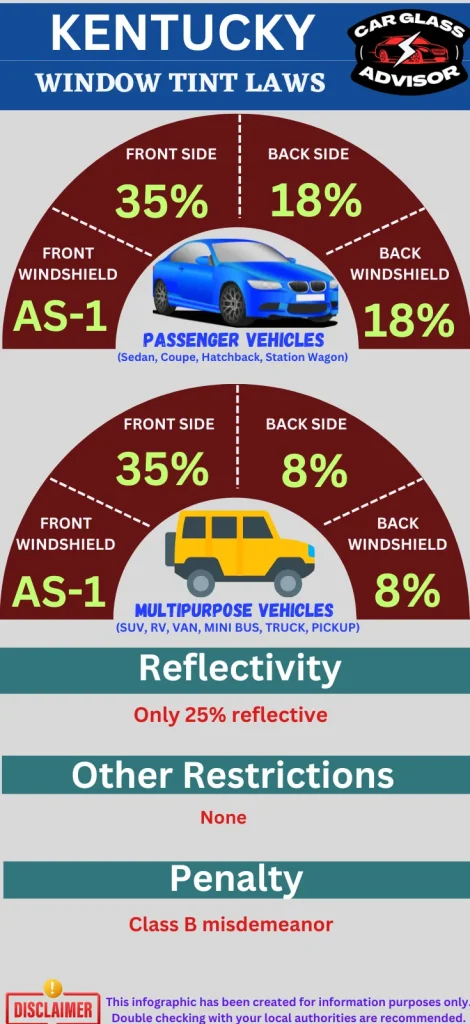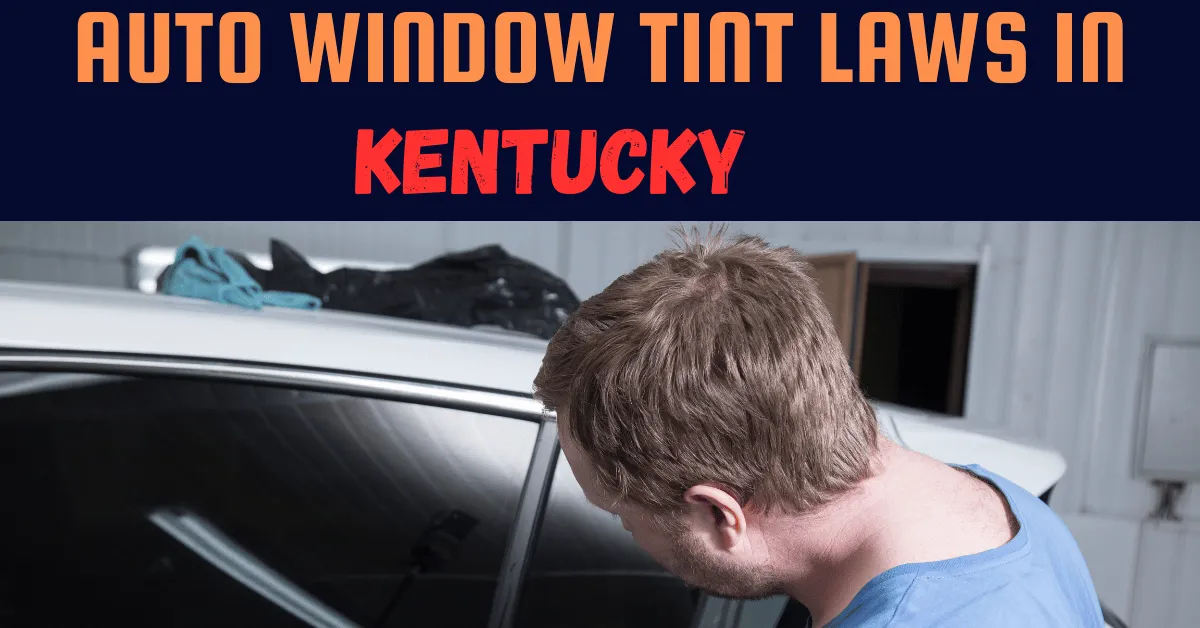Back in 1994, Kentucky laid down the law on car window tinting. With a comprehensive set of rules and regulations, drivers need to ensure their vehicle’s tint complies with the state’s standards. The level of darkness and reflectivity are both important factors to keep in mind, and some additional guidelines. To avoid any unwanted fines, read up on all the information and documents provided. Stay safe and legal on the roads of Kentucky!
Understanding TWO KEY POINTS, such as, Visible Light Transmission (VLT) and Visible Light Reflection (VLR) is the most important for auto window tinting. In this discussion, I’ll explain both concepts, starting with VLT.
1. Window Tint Darkness in Kentucky (VLT)
Window Tint Darkness or Visible light transmission (VLT) is a measurement of the amount of light that passes through a film. It’s measured in percentages and can be from 0% to 100%. The higher the percentage, the more visible light is transmitted through the film.
Every state has a unique legal limitations. Therefore, if If you’re driving in Kentucky, it’s essential to note that the amount of light allowed to pass through your car’s tinted glass may differ from other states. Additionally, the tinting rules vary between passenger vehicles and multi-purpose vehicles. Therefore, it’s crucial to pay close attention to Kentucky’s unique tinting laws. Take the time to read and fully understand the regulations to avoid any potential issues or penalties.
Tint darkness laws for passenger vehicles (sedans) in Kentucky:
Windshield: You can use a non-reflective tint above the manufacturer’s AS-1 line.
Front Side windows: You can use maximum up to 35% tint darkness.
Back Side windows: You can use a maximum 18% tint darkness for backside windows.
Rear Window: You can use maximum 18% tint darkness for rear windows.
Tint darkness laws for multi-purpose vehicles (SUVs and vans) in Kentucky:
Windshield: You can use a non-reflective tint above the manufacturer’s AS-1 line.
Front Side windows: You can use up to 35% tint darkness for front side windows.
Back Side windows: You can use 8% tint darkness for backside windows.
Rear Window: You can use 8% tint darkness for rear windows.
2. Window Tint Reflection in Kentucky (VLR)
Window Tint Reflection or Visible light reflection (VLR) is the amount of light that a window film reflects. For window tinting, the percentage of visible light reflection (VLR) is also a crucial factor to consider. In Kentucky, the law dictates that a specific VLR percentage is permitted for tinted windows, so it’s essential to note this. The VLR percentage ranges from 0% to 100%, with a lower percentage showing less visible light being reflected into the car, resulting in more sunlight being blocked. So, be sure to pay attention to the VLR percentage as you adhere to Kentucky’s window tint laws.
Tint reflection laws for passenger vehicles (sedans) in Kentucky:
Front Side windows: Window tint installed on the front side windows of a passenger vehicle must not be more than 25% reflective.
Back Side windows: Window tint installed on the back side windows of a passenger vehicle must not be more than 35% reflective.
Tint reflection laws for multi-purpose vehicles (SUVs and Vans) in Kentucky:
Front Side windows: Window tint installed on the front side windows of a multipurpose vehicle must not be more than 25% reflective.
Back Side windows: Window tint installed on the backside windows of a multipurpose vehicle must not be more than 35% reflective.
Other Kentucky Window Tint Rules and Regulations:
In Kentucky, adhering to the rules and regulations on window tinting is crucial. Failure to do so can result in unwanted consequences. Apart from keeping the darkness and glare of each window within a specific percentage, there are several other guidelines to follow. Being aware of these regulations can help you avoid any potential legal issues. So, ensure that you are fully informed and comply with all these requirements on window tinting for your vehicle:
Side Mirrors: In Kentucky, vehicles are required to have dual side mirrors if the back window is tinted. This is because tinted windows can reduce visibility, making it harder for the driver to see what is happening behind them. The mirrors help to compensate for this by providing a wider field of view. They also help to reduce the risk of accidents by making it easier for the driver to see other vehicles and pedestrians. Additionally, side mirrors can also help to increase fuel efficiency by reducing wind resistance and drag on the vehicle. To ensure that your vehicle complies with Kentucky state laws, make sure that your side mirrors are in good working order and that they are properly adjusted to give you the best view possible.
Restricted Colors: In Kentucky, there is no specific law that prohibits the use of certain colors for car window tint. Therefore, you can use gray, green, bronze, and neutral smoke colors on your vehicle’s windows with no issue. However, it’s important to note that all vehicles in Kentucky must comply with the state’s regulations regarding window tinting, which stipulate the minimum light transmission required on all windows. This means that, regardless of the color of the tint, if the tint does not meet the legal light transmission requirement, it is considered illegal.
Certificates: Manufacturers of the film must certify the film they sell in the Kentucky state. The address and the name must clearly be seen on that certificate. Drivers must be able to show the certificate when asked, so it is sensible to keep it with them at all times.
Stickers: Kentucky State law also requires tint film installation companies must also give the vehicle’s owner a sticker or certificate with their name and address.
Medical Exceptions: In Kentucky, there is no provision in state law that allows for medical exemptions to the regulations governing window tinting. This means that individuals with medical conditions that make them sensitive to light, such as lupus or other autoimmune disorders, are not permitted to use special tint on their vehicle windows. All vehicles in Kentucky must comply with the state’s regulations regarding window tinting, which stipulate the minimum light transmission required on all windows. These regulations are in place for safety reasons, as excessively tinted windows can reduce visibility and increase the risk of accidents.
Penalties For Non-Compliance: In Kentucky, if a vehicle is found to have illegal window tinting, the penalty is considered a Class B misdemeanor. This is a criminal offense that can result in fines, penalties and/or jail time. The exact amount of the fine will vary depending on the specific circumstances of the case and the discretion of the court. In addition to fines, individuals found guilty of illegal window tinting may also be required to remove the tint from their vehicle at their own expense. In some cases, they may also be required to pay additional fines or penalties. Repeat offenders may face even harsher penalties. It is important to note that while the state of Kentucky does not have medical exemptions, some municipalities may have their own regulations and penalties, so it’s always best to check with local authorities to ensure compliance with all applicable laws and regulations.

Conclusion
The 2023 Kentucky window tint law declares that there are specific regulations regarding window tinting on vehicles that require state registration. The regulations stipulate that on the windshield, non-reflective tint is allowed above the manufacturer’s AS-1 line, which is typically the top 6 inches of the windshield. The tint on the front side windows must allow more than 35% of light to pass through, while the tint on the back side windows and rear window must allow more than 18% of light to pass through. These regulations are in place for safety reasons, as excessively tinted windows can reduce visibility and increase the risk of accidents. Reflective window tint is illegal in Kentucky. It is recommended to check with local authorities for compliance with all applicable laws and regulations.
Disclaimer
The information on this site is provided for informational purposes only and should not be construed as legal advice or as a substitute for the advice of an attorney. No user of this site, or any other person or entity that may have received this information, shall rely upon the information contained as creating an attorney-client relationship between such user and Car Glass Advisor. The rules and regulations pertaining to car window tint in Kentucky may change at any time. Therefore, please contact a local lawyer licensed to practice in your jurisdiction.

